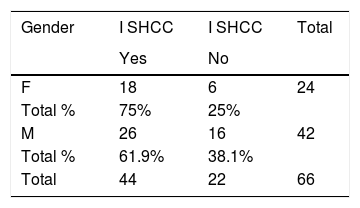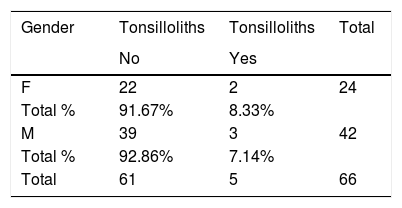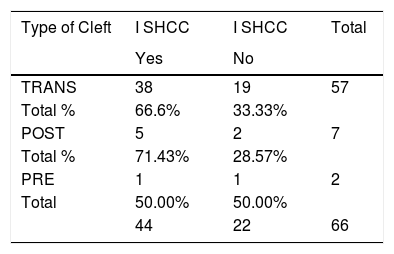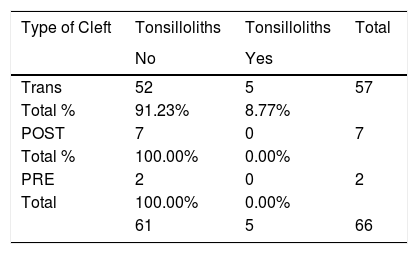Tonsilloliths and abnormal stylohyoid complex may have similar symptoms to others of different aetiology. Individuals with cleft lip and palate describe similar symptoms because of the anatomical implications that are peculiar to this anomaly. The aim of this study was to determine the prevalence of abnormal stylohyoid complex and tonsilloliths on cone beam computed tomography in individuals with cleft lip and palate.
MethodsAccording to the inclusion and exclusion criteria, 66 CT scans out of 2794 were analysed, on i-Cat® vision software with 0.8 index Kappa intra-examiner.
ResultsThe total prevalence of ossification of the incomplete stylohyoid complex in individuals with cleft lip and palate was 66.6%; the prevalence of these findings in females was 75% and 61.9% in males. The total prevalence of tonsilloliths was 7.5%.
ConclusionIt is important to ascertain calcification of the stylohyoid complex and tonsilloliths in the radiological report, due to the anatomical proximity and similar symptomatology to other orofacial impairments in individuals with cleft lip and palate, focusing on females with oral cleft formation, patients with incisive trans foramen cleft and incisive post foramen cleft because they are more prevalent. Greater knowledge of the anatomical morphometry of individuals with cleft lip and palate greatly contributes towards the selection of clinical behaviours and the quality of life of these patients, since cleft lip and palates one of the most common anomalies.
Los tonsilolitos y alteraciones en el complejo estilohioideo pueden presentar similar sintomatología a otras de diferente etiología. Los individuos con fisura labiopalatina describen similares síntomas en razón de las repercusiones anatómicas propias de esta anomalía. El objetivo de este estudio fue determinar la prevalencia de alteraciones del complejo estilohioideo y tonsilolitos en exámenes de tomografía computarizada de haz cónico en individuos con fisura labiopalatina.
MétodosSegún criterios de inclusión y exclusión fueron analizadas 66 tomografías de 2.794 tomografías, en el software i- Cat visión ® con índice Kappa 0,8 intraexaminador.
ResultadosLa prevalencia total de osificación del complejo estilohioideo incompleto en individuos con fisura labiopalatina fue de 66,6%, la prevalencia de estos hallazgos en el género femenino fue de 75% y 61,9% en el género masculino. La prevalencia total de tonsilolitos fue de 7,5%.
ConclusiónEs de relevancia constatar en el informe radiológico la presencia de la calcificación del complejo estilo-hioideo y tonsilolitos. Debido a la proximidad anatómica y similar sintomatología clínica con otras alteraciones orofaciales presentes en los individuos con fisura labiopalatina, haciendo énfasis en individuos con fisura labiopalatina del género femenino, pacientes con fisura tipo transformen incisivo y posforamen incisivo por presentar mayor prevalencia. Conocer más sobre la morfometría anatómica de individuos con fisura labiopalatina coadyuva relevantemente en la elección de conductas clínicas y calidad de vida de estos pacientes, teniendo presente que la fisura labiopalatina es una de las anomalías más comunes.











